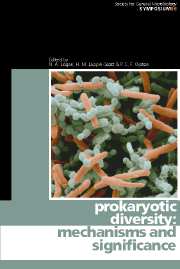Book contents
- Frontmatter
- Contents
- Contributors
- Editors' Preface
- Microbial diversity in the era of genomics
- Patterns in prokaryotic biodiversity
- A putative RNA-interference-based immune system in prokaryotes: the epitome of prokaryotic genomic diversity
- The significance of prokaryote diversity in the human gastrointestinal tract
- The genetics of phenotypic innovation
- Minimal genomes required for life
- Evolution of the core of genes
- Biogeographical diversity of archaeal viruses
- Is there a link between Chlamydia and heart disease?
- Unculturable oral bacteria
- Comparative genomics – what do such studies tell us about the emergence and spread of key pathogens?
- Spread of genomic islands between clinical and environmental strains
- Evolving gene clusters in soil bacteria
- Unusual micro-organisms from unusual habitats: hypersaline environments
- Genomic islands and evolution of catabolic pathways
- Horizontal gene transfer and its role in the emergence of new phenotypes
- Index
Is there a link between Chlamydia and heart disease?
Published online by Cambridge University Press: 06 July 2010
- Frontmatter
- Contents
- Contributors
- Editors' Preface
- Microbial diversity in the era of genomics
- Patterns in prokaryotic biodiversity
- A putative RNA-interference-based immune system in prokaryotes: the epitome of prokaryotic genomic diversity
- The significance of prokaryote diversity in the human gastrointestinal tract
- The genetics of phenotypic innovation
- Minimal genomes required for life
- Evolution of the core of genes
- Biogeographical diversity of archaeal viruses
- Is there a link between Chlamydia and heart disease?
- Unculturable oral bacteria
- Comparative genomics – what do such studies tell us about the emergence and spread of key pathogens?
- Spread of genomic islands between clinical and environmental strains
- Evolving gene clusters in soil bacteria
- Unusual micro-organisms from unusual habitats: hypersaline environments
- Genomic islands and evolution of catabolic pathways
- Horizontal gene transfer and its role in the emergence of new phenotypes
- Index
Summary
CHLAMYDIAE
Chlamydiae are Gram-negative bacteria that are obligately intracellular parasites (Moulder et al., 1984). Chlamydia trachomatis and Chlamydia pneumoniae are human pathogens. C. trachomatis is a leading cause of preventable blindness in developing nations and sexually transmitted disease in the Western world (Moulder et al., 1984). C. pneumoniae is an aetiological agent of acute respiratory diseases (Grayston et al., 1998) and causes approximately 10% of pneumonia cases and 5% of bronchitis and sinusitis cases in adults (Grayston et al., 1993). Chlamydia psittaci is an avian pathogen. Humans can be infected with C. psittaci, through direct contact with an infected bird or by inhalation of dust contaminated with excreta of infected birds. This disease, known as psittacosis, is a severe pneumonia with systemic symptoms (Moulder et al., 1984; Everett et al., 1999). Other chlamydial species infect animals (Fukushi & Hirai, 1992; Everett et al., 1999). Although rare, humans may be infected through contact with lower mammals.
Chlamydial infection often becomes chronic and induces chronic inflammatory responses leading to tissue destruction, fibrosis and scarring and, thus, has been termed a disease of immunopathology (Grayston et al., 1985). For example, repeated/chronic ocular infection with C. trachomatis can result in blindness and genital tract infection can result in obstruction of the fallopian tube and infertility. Considerable recent attention has been focused on the association of C. pneumoniae with atherosclerosis, a disease of chronic inflammation and the leading cause of morbidity and mortality in the Western world.
- Type
- Chapter
- Information
- Prokaryotic DiversityMechanisms and Significance, pp. 145 - 162Publisher: Cambridge University PressPrint publication year: 2006



